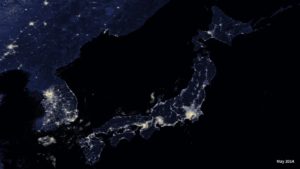
The Japanese government will establish a command centre within the Self-Defence Forces (SDF) to monitor space debris and traffic in Earth orbit as well as to carry out surveillance on foreign satellites as they orbit over Japanese territory.
The SDF command centre could be established as early as fiscal year 2022 and is supposed to be outlined in the National Defence Programme Guidelines that Tokyo plans to review in December 2018, according to Japanese government sources.
Itsunori Onodera, a former defence minister who runs the Liberal Democratic Party’s working group dealing with the defence guideline revisions, spoke of the plan during a lecture he delivered in Tokyo on 19 November 2018.
The revised National Defence Programme Guidelines are designed to improve Japan’s ability to defend itself against cyber-attacks, space threats, and electronic warfare.
With regard to the SDF’s space situational awareness (SSA) command centre, the Japanese Ground, Air, and Maritime SDF’s will jointly operate the facility.
The Japanese government is increasingly aware of, and concerned with, space debris as a growing threat to its satellites orbiting Earth, as the volume orbiting at very high speeds has grown markedly in recent years.
The SSA system is being created to address the space debris threat and collect intelligence on foreign space capabilities, such as those of China, that Japan, the U.S., and other friends and allies believe is developing antisatellite (ASAT) and counterspace weapons and technologies.
The Japanese Ministry of Defence (MoD) has requested 26.8 billion yen (U.S.$238 million) for the SDF’s SSA command centre in the next fiscal year’s budget.
The SDF’s SSA command centre will likely be based at the ASDF’s Fuchu Base in Fuchu on the outskirts of Tokyo, according to the Japanese government sources.
The Japanese Aerospace Exploration Agency (JAXA) will help operate the SSA command centre, and the Japanese MoD will share information collected by the facility with U.S. forces.
A radar capable of monitoring activities in Earth orbit at an altitude of at least 5,800 kilometres will be built near the city of Sanyo-Onoda in Japan’s Yamaguchi Prefecture at the former site of an JMSDF receiving station.
The National Defence Programme Guidelines are also expected to call for greater use of defence technologies powered by Artificial Intelligence (AI), such as unmanned vehicles, in order to address growing manpower shortages across the SDF.
The SDF is also looking to raise the retirement age of SDF personnel as well as make greater use of Japanese reservists in order to address these shortages.





